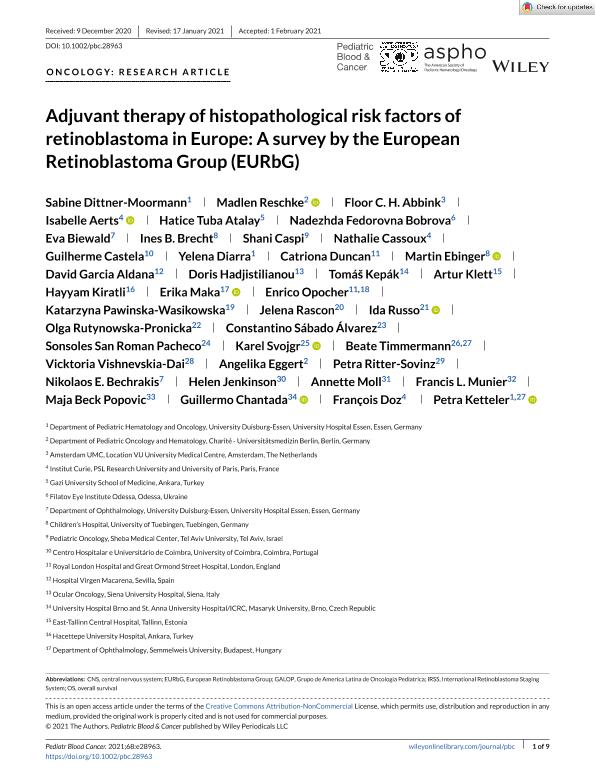Artículo
Adjuvant therapy of histopathological risk factors of retinoblastoma in Europe: A survey by the European Retinoblastoma Group (EURbG)
Dittner Moormann, Sabine; Reschke, Madlen; Abbink, Floor C. H.; Aerts, Isabelle; Atalay, Hatice Tuba; Fedorovna Bobrova, Nadezhda; Biewald, Eva; Brecht, Ines B.; Caspi, Shani; Cassoux, Nathalie; Castela, Guilherme; Diarra, Yelena; Duncan, Catriona; Ebinger, Martin; Garcia Aldana, David; Hadjistilianou, Doris; Kepák, Tomá; Klett, Artur; Kiratli, Hayyam; Maka, Erika; Opocher, Enrico; Pawinska Wasikowska, Katarzyna; Rascon, Jelena; Russo, Ida; Rutynowska Pronicka, Olga; Sábado Álvarez, Constantino; Pacheco, Sonsoles San Roman; Svojgr, Karel; Timmermann, Beate; Vishnevskia Dai, Vicktoria; Eggert, Angelika; Ritter Sovinz, Petra; Bechrakis, Nikolaos E.; Jenkinson, Helen; Moll, Annette; Munier, Francis L.; Popovic, Maja Beck; Chantada, Guillermo Luis ; Doz, François; Ketteler, Petra
; Doz, François; Ketteler, Petra
 ; Doz, François; Ketteler, Petra
; Doz, François; Ketteler, Petra
Fecha de publicación:
06/2021
Editorial:
Wiley-liss, div John Wiley & Sons Inc.
Revista:
Pediatric Blood & Cancer
ISSN:
1545-5009
Idioma:
Inglés
Tipo de recurso:
Artículo publicado
Clasificación temática:
Resumen
Introduction: Advanced intraocular retinoblastoma can be cured by enucleation, but spread of retinoblastoma cells beyond the natural limits of the eye is related to a high mortality. Adjuvant therapy after enucleation has been shown to prevent metastasis in children with risk factors for extraocular retinoblastoma. However, histological criteria and adjuvant treatment regimens vary and there is no unifying consensus on the optimal choice of treatment. Method: Data on guidelines for adjuvant treatment in European retinoblastoma referral centres were collected in an online survey among all members of the European Retinoblastoma Group (EURbG) network. Extended information was gathered via personal email communication. Results: Data were collected from 26 centres in 17 countries. Guidelines for adjuvant treatment were in place at 92.3% of retinoblastoma centres. There was a consensus on indication for and intensity of adjuvant treatment among more than 80% of all centres. The majority of centres use no adjuvant treatment for isolated focal choroidal invasion or prelaminar optic nerve invasion. Patients with massive choroidal invasion or postlaminar optic nerve invasion receive adjuvant chemotherapy, while microscopic invasion of the resection margin of the optic nerve or extension through the sclera are treated with combined chemo- and radiotherapy. Conclusion: Indications and adjuvant treatment regimens in European retinoblastoma referral centres are similar but not uniform. Further biomarkers in addition to histopathological risk factors could improve treatment stratification. The high consensus in European centres is an excellent foundation for a common European study with prospective validation of new biomarkers.
Palabras clave:
BIOMARKER
,
CHEMOTHERAPY
,
CHILDHOOD CANCER
,
METASTASIS
,
RADIOTHERAPY
,
RB1 GENE
Archivos asociados
Licencia
Identificadores
Colecciones
Articulos(IIMT)
Articulos de INSTITUTO DE INVESTIGACIONES EN MEDICINA TRASLACIONAL
Articulos de INSTITUTO DE INVESTIGACIONES EN MEDICINA TRASLACIONAL
Citación
Dittner Moormann, Sabine; Reschke, Madlen; Abbink, Floor C. H.; Aerts, Isabelle; Atalay, Hatice Tuba; et al.; Adjuvant therapy of histopathological risk factors of retinoblastoma in Europe: A survey by the European Retinoblastoma Group (EURbG); Wiley-liss, div John Wiley & Sons Inc.; Pediatric Blood & Cancer; 68; 6; 6-2021; 1-9
Compartir
Altmétricas



